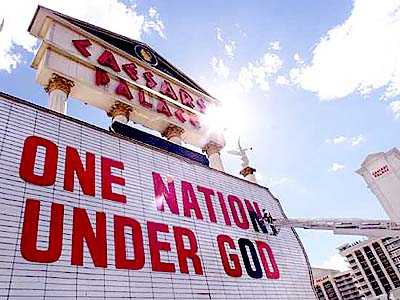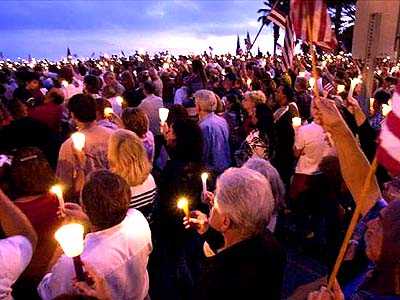

Conservatives perverting America's symbols
From the LA Times, 7/4/02:
COMMENTARY
New Life in Old Symbols
Issues of earlier times find modern contexts.
By PETER DREIER and DICK FLACKS
Peter Dreier teaches politics and public policy at Occidental College and is co-author of "Place Matters: Metropolitics for the 21st Century"(University Press of Kansas, 2001).
This Fourth of July is likely to be the most fervent in many years. Since Sept. 11, the nation has seen a dramatic increase in public expressions of patriotism, including displays of the flag, songs, parades and red, white and blue everything. Most pundits interpret this as a sign that the nation is in a conservative mood, but the reality is more complicated. Loyalty to country is neither conservative nor liberal. How one expresses one's patriotism depends on the core values one associates with the United States.
A case in point is the current controversy over the Pledge of Allegiance. The U.S. 9th Circuit Court of Appeals ruling that the words "under God" in the pledge violate the 1st Amendment was an incredible act of bad political timing. Thanks to the uproar, however, Americans learned a valuable history lesson. The original version of the pledge did not include that phrase or any reference to religion. "Under God" was added by Congress in 1954 when many politicians thought the nation was threatened by godless communism. Lost in the public dispute is any understanding of what its author, Francis Bellamy, was trying to accomplish—or its relevance for today. Bellamy, a Baptist minister, wrote the pledge in 1892 during the Gilded Age, when reformers were outraged by the behavior of corporate robber barons who were exploiting workers, gouging consumers and corrupting politics with their money. Bellamy was a leading Christian socialist who hoped that the pledge, and especially the line "one nation indivisible with liberty and justice for all," would promote a more egalitarian vision. Bellamy penned the pledge for Youth's Companion, a magazine for young people. A few years earlier, the magazine had sponsored a largely successful campaign to sell American flags to public schools. In 1891, the magazine hired Bellamy to organize a campaign to celebrate the 400th anniversary of Christopher Columbus' discovery. Bellamy gained the support of the National Education Assn., President Benjamin Harrison and Congress for a national ritual observance in the schools, and he wrote the Pledge of Allegiance as part of the program's flag salute ceremony.
Bellamy's view that unbridled capitalism, materialism and individualism betrayed America's promise was widely shared in the 19th and early 20th centuries. Many American radicals and progressive reformers proudly asserted their patriotism. To them, the U.S. stood for basic democratic values: economic and social equality, mass participation in politics, free speech and civil liberties, elimination of the second-class citizenship of women and racial minorities, a welcome mat for the world's oppressed people.

Most Americans are unaware that much of our patriotic culture—including many of the symbols and songs that have become increasingly popular since Sept. 11—were created by writers of decidedly left-wing sympathies.
Consider Emma Lazarus' words, written in 1883 and inscribed on the Statue of Liberty: "Give me your tired, your poor / Your huddled masses yearning to breathe free." She was a well-respected poet, a strong supporter of Henry George's "socialistic" single-tax program and a friend of William Morris, a leading British socialist. Her welcome to the "wretched refuse" of the Earth was meant to project an inclusive and egalitarian definition of the American dream.
The words to "America the Beautiful" were written in 1893 by Katherine Lee Bates, a professor of English at Wellesley College. Bates was a poet and a lesbian whose book "America the Beautiful and Other Poems" expressed outrage over U.S. imperialism in the Philippines. She was part of progressive reform circles in the Boston area concerned about labor rights, urban slums and women's suffrage. The poem's final line—"and crown thy good with brotherhood, from sea to shining sea"—is an appeal for social justice.
Many Americans consider Woody Guthrie's song "This Land Is Your Land," penned in 1940, to be our unofficial national anthem. Guthrie was inspired to write it as an answer to Irving Berlin's popular "God Bless America," which he thought failed to recognize that America belonged to "the people." The lyrics reflect Guthrie's fusion of patriotism and support for the underdog. He celebrates the nation's natural beauty and bounty but criticizes the country for its failure to share its riches, reflected in the song's last and least-known verse: "One bright sunny morning in the shadow of the steeple / By the relief office I saw my people. / As they stood hungry I stood there wondering / If this land was made for you and me?"
In recent decades, Bruce Springsteen has most closely followed in the Guthrie tradition. From "Born in the USA" to his songs about Tom Joad (the militant protagonist in John Steinbeck's "The Grapes of Wrath") to "Land of Hope and Dreams" to his "My City of Ruins," which he recently dedicated to the victims of the Sept. 11 tragedy, Springsteen has championed the downtrodden while challenging the nation to live up to its ideals. Every day, millions of Americans recite the Pledge of Allegiance, sing "American the Beautiful" or "This Land Is Your Land" and memorize the words on the Statue of Liberty without knowing the names of their authors or the political context in which they were written. The progressive authors of much of the nation's patriotic iconography rejected blind nationalism, militaristic drumbeating and sheep-like conformism. They believed that America's core claims—fairness, equality, freedom, justice—were their own.

The war on terrorism has diverted attention from the reality that the U.S. now confronts a new Gilded Age. The gap between rich and poor is widening. The unbridled greed and political influence-peddling demonstrated by many executives of large corporations has triggered another wave of public outrage. The behavior of large HMOs and pharmaceutical companies angers Americans who can't afford the cost of basic health care. The growing power of American-based global firms that show no loyalty to this country in terms of where they move their jobs, the taxes they pay or the environment they pollute has led to a grass-roots movement for fairer trade.
The recent controversy over the pledge has focused on the words "under God." But if Francis Bellamy were alive today, he'd be more concerned that the actions of big business and many politicians were undermining his vision of a nation that promises "liberty and justice for all."
Copyright 2002 Los Angeles Times
Hysteria over the Pledge
From the LA Times:
The pledge's refuge for scoundrels
Orange County kerfuffle aside, the Pledge of Allegiance comes with a long history of persecution.
By Andrew Cohen, ANDREW COHEN is CBS News' chief legal analyst.
November 14, 2006
LAST WEEK, while tens of millions of us were voting in the midterm elections, a small group of undergraduate politicians at Orange Coast College in Costa Mesa voted to ban the recitation of the Pledge of Allegiance at their student government meetings.
"Loyalty ought to be something the government earns through performance, not through reciting a pledge," said one of three student "rebels," Jason Bell, who ran for and won his student office, the news service Reuters reported, while wearing a "revolutionary-style beret," whatever that is supposed to mean.
The ban — passed by a 3-2 vote — does not apply to other school groups or campus activities and was neither endorsed nor criticized by school administrators. But that didn't stop the story from quickly causing the sort of "patriotic" hysteria that emerges when someone steps out of line, pledge-wise. One fellow student, for example, reportedly became so distraught by the announcement of the ban that she immediately began reciting the pledge. Another accused the student leaders of "anti-Americanism." By the end of the week, the story was posted on the Christian Broadcasting Network website.
Because these students obviously have a little extra time on their hands, and with their holiday break coming up, I recommend that they all read Richard J. Ellis' book, "To the Flag," an excellent and little-known work that also ought to be required reading for every grown-up politician who might be tempted to finger-point in the debate over the pledge. "The words of the pledge," Ellis writes, "have inspired millions, but they have also been used to coerce and intimidate; to compel conformity and to silence dissent."
Indeed, as Ellis illustrates, the Pledge of Allegiance was created and promoted in the late 19th century, a period of intense social upheaval in this country as waves of immigrants from Eastern Europe came to the United States and upset the nation's ethnic (Anglo-Saxon) and religious (Protestant) apple cart. It was designed as a paean to nationalism, but it quickly became a nasty, prejudiced test of patriotism during a time, much like our own, when fear and suspicion over enemies, foreign and domestic, gripped the country.
It is a mistake for anyone to place the pledge on a par with the Declaration of Independence, the preamble to the Constitution or even the national anthem when it comes to hymns that bring us together in voice and spirit. But people have long misunderstood and misapplied the pledge.
The dispute at Orange Coast College is mainly about loyalty to government and not the controversial words "under God" in the pledge — the dispute that most recently has drawn our legal and political attention. But it doesn't matter. Even before those words were added in the 1950s as a bulwark against communism, Americans were hurting each other — literally — in the name of the pledge.
In Pennsylvania in the 1930s, Ellis notes in his book, officials didn't just expel students from school for not reciting the pledge, they whipped and choked and beat them too. School officials would report these students to government authorities, who then got court orders to separate the parents from their children, sometimes for years. Mobs of citizens persecuted Jehovah's Witnesses and others who refused to recite the pledge. It took a 1943 U.S. Supreme Court decision, which declared that people had a 1st Amendment right not to be forced by the government into reciting the pledge, to stop the physical violence. But divisions over the pledge clearly remain.
So the rabble-rousing students at Orange Coast College are merely doing what their predecessor protesters have done for more than a century. And the folks who are criticizing them have a long history as well.
Never mind Ellis' must-read book. Listen to what then-Minnesota Gov. Jesse "The Body" Ventura had to say when he vetoed a measure requiring public school students to recite the pledge at least once a week: "There is much more to being a patriot and a citizen than reciting a pledge or raising a flag."
More on the Pledge of Allegiance
Navajo Pledge of Allegiance
Related links
God bless secular America
Victor or victim: our new national anthem?
Corporate culture: rotten to the core
America's cultural mindset
Readers respond
"Newdow does not like the Pledge because it is speech involving a religion he does not like."
"This pledge issue is about intolerance of monotheism."
|
. . . |

|
All material © copyright its original owners, except where noted.
Original text and pictures © copyright 2007 by Robert Schmidt.
Copyrighted material is posted under the Fair Use provision of the Copyright Act,
which allows copying for nonprofit educational uses including criticism and commentary.
Comments sent to the publisher become the property of Blue Corn Comics
and may be used in other postings without permission.